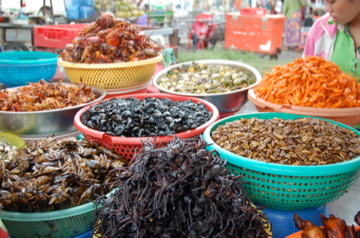The Six-Legged Meat of the Future
Posted by Big Gav in agriculture, food, insects
The Wall Street Journal points out that artificial meat isn't the only way of augmenting food supplies to fed an expanded population in future - insects may also become part of our diet - The Six-Legged Meat of the Future. Mmmm - fried spider...
At the London restaurant Archipelago, diners can order the $11 Baby Bee Brulee: a creamy custard topped with a crunchy little bee. In New York, the Mexican restaurant Toloache offers $11 chapulines tacos: two tacos stuffed with Oaxacan-style dried grasshoppers.
Could beetles, dragonfly larvae and water bug caviar be the meat of the future? As the global population booms and demand strains the world's supply of meat, there's a growing need for alternate animal proteins. Insects are high in protein, B vitamins and minerals like iron and zinc, and they're low in fat. Insects are easier to raise than livestock, and they produce less waste. Insects are abundant. Of all the known animal species, 80% walk on six legs; over 1,000 edible species have been identified. And the taste? It's often described as "nutty." ...
Insects have a reputation for being dirty and carrying diseases—yet less than 0.5% of all known insect species are harmful to people, farm animals or crop plants. When raised under hygienic conditions—eating bugs straight out of the backyard generally isn't recommended—many insects are perfectly safe to eat.
Meanwhile, our food needs are on the rise. The human population is expected to grow from six billion in 2000 to nine billion in 2050. Meat production is expected to double in the same period, as demand grows from rising wealth. Pastures and fodder already use up 70% of all agricultural land, so increasing livestock production would require expanding agricultural acreage at the expense of rain forests and other natural lands. Officials at the United Nations Food and Agriculture Organization recently predicted that beef could become an extreme luxury item by 2050, like caviar, due to rising production costs.
Raising insects for food would avoid many of the problems associated with livestock. For instance, swine and humans are similar enough that they can share many diseases. Such co-infection can yield new disease strains that are lethal to humans, as happened during a swine fever outbreak in the Netherlands in the late 1990s. Because insects are so different from us, such risks are accordingly lower.
Insects are also cold-blooded, so they don't need as much feed as animals like pigs and cows, which consume more energy to maintain their body temperatures. Ten pounds of feed yields one pound of beef, three pounds of pork, five pounds of chicken and up to six pounds of insect meat.
Insects produce less waste, too. The proportion of livestock that is not edible after processing is 30% for pork, 35% for chicken, 45% for beef and 65% for lamb. By contrast, only 20% of a cricket is inedible.
Raising insects requires relatively little water, especially as compared to the production of conventional meat (it takes more than 10 gallons of water, for instance, to produce about two pounds of beef). Insects also produce far less ammonia and other greenhouse gases per pound of body weight. Livestock is responsible for at least 10% of all greenhouse gas emissions.
Raising insects is more humane as well. Housing cattle, swine or chicken in high densities causes stress to the animals, but insects like mealworms and locusts naturally like to live in dense quarters. The insects can be crowded into vertical stacked trays or cages. Nor do bug farms have to be restricted to rural areas; they could sprout up anywhere, from a suburban strip mall to an apartment building. Enterprising gourmets could even keep a few trays of mealworms in the garage to ensure a fresh supply.
The first insect fare is likely to be incorporated subtly into dishes, as a replacement for meat in meatballs and sauces. It also can be mixed into prepared foods to boost their nutritional value—like putting mealworm paste into a quiche. And dry-roasted insects can be used as a replacement for nuts in baked goods like cookies and breads.
We continue to make progress in the Netherlands, where the ministry of agriculture is funding a new $1.3 million research program to develop ways to raise edible insects on food waste, such as brewers' grain (a byproduct of beer brewing), soyhulls (the skin of the soybean) and apple pomace (the pulpy remains after the juice has been pressed out). Other research is focusing on how protein could be extracted from insects and used in processed foods.
Though it is true that intentionally eating insects is common only in developing countries, everyone already eats some amount of insects. The average person consumes about a pound of insects per year, mostly mixed into other foods. In the U.S., most processed foods contain small amounts of insects, within limits set by the Food and Drug Administration. For chocolate, the FDA limit is 60 insect fragments per 100 grams. Peanut butter can have up to 30 insect parts per 100 grams, and fruit juice can have five fruit-fly eggs and one or two larvae per 250 milliliters (just over a cup). We also use many insect products to dye our foods, such as the red dye cochineal in imitation crab sticks, Campari and candies. So we're already some of the way there in making six-legged creatures a regular part of our diet.
Not long ago, foods like kiwis and sushi weren't widely known or available. It is quite likely that in 2020 we will look back in surprise at the era when our menus didn't include locusts, beetle larvae, dragonfly larvae, crickets and other insect delights.






